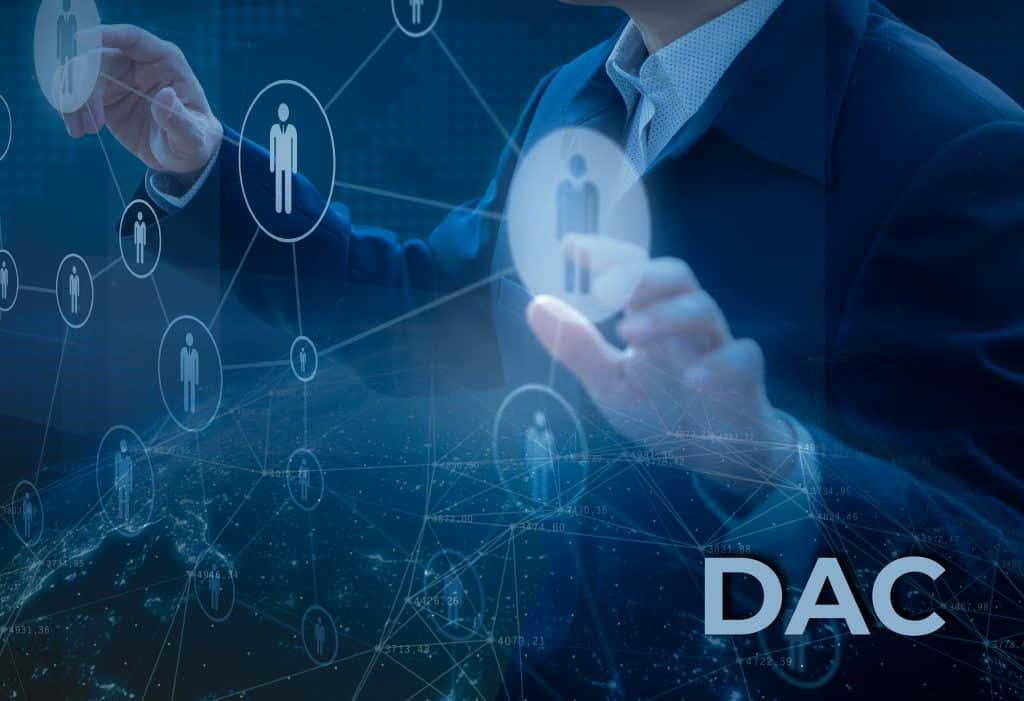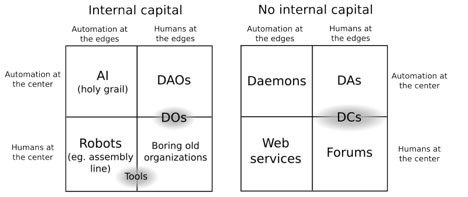
Table of Contents
ToggleSurely, during your journey in the cryptocurrency universe, you will have come across the acronyms DAO, DAC, DAS etc…
If you’ve been intrigued by these acronyms and want to know what’s behind them, you’ve come to the right place at the right time.
In the meantime, I’ll show you today what a DAC or Decentralized Autonomous Corporation is and why it is so important in the crypto ecosystem.
Definition of DAC
DAC (Decentralized Autonomous Corporation or Decentralized Autonomous Community) is a subclass of DAO (Decentralized autonomous organization) and it’s a community that works through rules encoded as smart contracts.
To be more precise, a DAC is a company managed by a group of people self-governing and functioning autonomously. Such companies are guided by rules encoded in computer programs called smart contracts that reside on the blockchain.
But what exactly is a decentralized corporation, in which it differs from a decentralized organization and which it has in common with Decentralized Applications.
To understand this, let’s quickly see what a DAO is, what Ðapps are and how DAOs differ from Ðapps and DACs.
WHAT IS DAO

In 2014 Vitalik Buterin gave a definition of DAO in the article «DAOs, DACs, DAs and More: An Incomplete Terminology Guide«, published in the blog of Ethereum.org.
In this article, Vitalik defines a DAO as “It is an entity that lives on the internet and exists autonomously, but also heavily relies on hiring individuals to perform certain tasks that the automaton itself cannot do“, thus referring to an entity that performs the functions of a real organization.
In the following picture, you can see how Daos have automation in the center, humans at the edges, and have internal capital. A DAO without internal capital is a DA (Decentralized Agent).

Source: Blog.ethereum.org
So, a DAO on the Ethereum blockchain is a set of rules implemented as Smart Contract (or code running on the blockchain) which may hold and issue funds according to a set of rules.
Many consider Bitcoin the first DAO.
Vitalik Buterin explained that DAOs could be programmed to work without human interactivity, as long as smart contracts are supported by a full Turing language.
Nevertheless, we can say that a DAO differs from an AI/AA (Artificial Intelligence/Autonomous Agent), in the fact that an AI is completely autonomous, while a DAO requires large participation of humans who, in order to function, interact according to a defined protocol from the DAO.
What are Ðapps
Decentralized applications (Ðapps) are digital applications running on a blockchain or P2P network of computers and are precisely decentralized because they are not subject to the control of a single authority.
The definition of a Ðapp is well explained by David Johnston in its white-paper:
For an application to be considered a Ðapp, it must meet the following criteria:
The application must be fully open source, must operate independently and without an entity that controls most of its tokens. All changes to the application must be decided by the consent of its users.
Data and records of its operations shall be stored cryptographically in a public and decentralized blockchain to avoid any central point of error.
Ðapp vs DAO
Although the two concepts are sometimes used interchangeably, Ðapp and DAO differ mainly in terms of automation.
Ðapps based on blockchain have a very low level of automation, since, while excluding human intervention, its potential modifications and improvements are not based on AI and self-learning but can only be carried out on the basis of consensus between members.
A DAO instead is completely autonomous, since it is equipped with a very high level of automation. The application should make the decision based on its intelligence and improve itself based on the results of the decisions taken.
So a DAO could be seen as a type of Ðapp, but a Ðapp is not necessarily a DAO.
What are DACs

The distributed autonomous company (DAC) is the business model of many companies in the cryptographic space.
The first mention of the DAC is due to Daniel Larimer who was the first to propose the concept of ” Distributed Autonomous Corporations ” in an article published in September 2013. According to Larimer, the well-known character of the blockchain ecosystem:
“Distributed Autonomous Corporations (DAC) run without any human involvement under the control of an incorruptible set of business rules. (That’s why they must be distributed and autonomous.) These rules are implemented as publicly auditable open-source software distributed across the computers of their stakeholders. You become a stakeholder by buying “stock” in the company or being paid in that stock to provide services for the company. This stock may entitle you to a share of its “profits”, participation in its growth, and/or a say in how it is run.”
So in a DAC, there is the concept of shares that give their owners the right to receive continuous receipts based on the success of the DAC.
Conversely, a DAO is non-profit and the way to make money with it is not by providing investments in the DAO itself, but by participating in its ecosystem.
An example of a DAC is “The DAO” which is an organized investment organization that uses an Ethereum Smart Contract.
So we can say that all DACs are DAOs, but not all DAOs are DACs.
How does a DAC work?
Basically a DAC is like a big company that runs automatically thanks to the programming of its smart contracts.
A DAC functions as an intelligent, programmable and verified digital property, running on a blockchain that is run through smart contracts. The code of a DAC is open source, so it’s free and accessible to anyone. The operating rules of a DAC apply to everyone and none of the participants have a privileged position over the others.
Also the decision-making power and any gains within the DAC are distributed among a large number of peer, each of which has the same level of authority.
The use of smart contracts in DACs gives them a high degree of autonomy in carrying out those operations that do not deserve human presence, which provides a significant degree of independence of the DAC from human intervention.
CHARACTERISTICS OF DACs
DACs are becoming an incredibly innovative application of crypto technology as they offer many advantages over traditionally organized companies because they are:
Distributed:
In a traditional society, the business organization is hierarchical, since the managing director has authority over all the decisional process.
A DAC has its ownership verified by a blockchain that is “distributed”, because it is managed by a large number of peers, none of which have a privileged position over the others. Decision-making power and the work done to produce the company’s product or service are also spread over a large number of peers, each of whom has equal authority..
So a DAC, unlike a traditional company, has an egalitarian and cooperative structure rather than hierarchical one.
Autonomous:
This is a feature inherited from DAO which, as we have seen before, has a high degree of autonomy because, to function, does not necessarily need human intervention.
Many, however, believe that the autonomy and automation of DACs are not an intrinsic feature since they work through human employees, hired by the crowd.
To conclude the list of features of the DACs, we can say that these are censorship-resistant business models, resistant to seizure of corporate financial assets, and guarantee greater productivity and efficiency of human capital.
Pros and cons of the DACs
Before concluding, let’s finally see what are the advantages and disadvantages of this business model.
Pros of the DACs
- AUTONOMY:
As mentioned above, one of the greatest benefits of DACs is the automation potential that can be achieved through the use of smart contracts.
- DECENTRALIZATION:
The decentralized and distributed character, thanks to the elimination of a centralized entity in the decision-making process, makes the DAC a company with a cooperative and egalitarian structure.
- CONSENSUS:
All decisions are made by consensus between their participants and their procedures and transactions are made public and transparent because they are registered in the blockchain.
Cons of DACs
- DACs do not have a defined legal framework, and this involves, for investors, taking risks. In addition, as it does not have a precise legal status, it is likely that this type of business organization will not be recognized by institutions such as the European Securities and Markets Authority (ESMA).
As it is a relatively new technology, there are still many aspects that need to be addressed to ensure greater security for those participating in this type of society.
DACs, due to their distributed, decentralized, and autonomous nature, seem to offer the potential to decentralize the whole world of business, finance, and economy.
Far from the corporate hierarchies of traditional enterprises, which only feed the corruption and clientele capitalism of our current corporate world, they are also able to offer a high degree of freedom and autonomy in our working lives.


